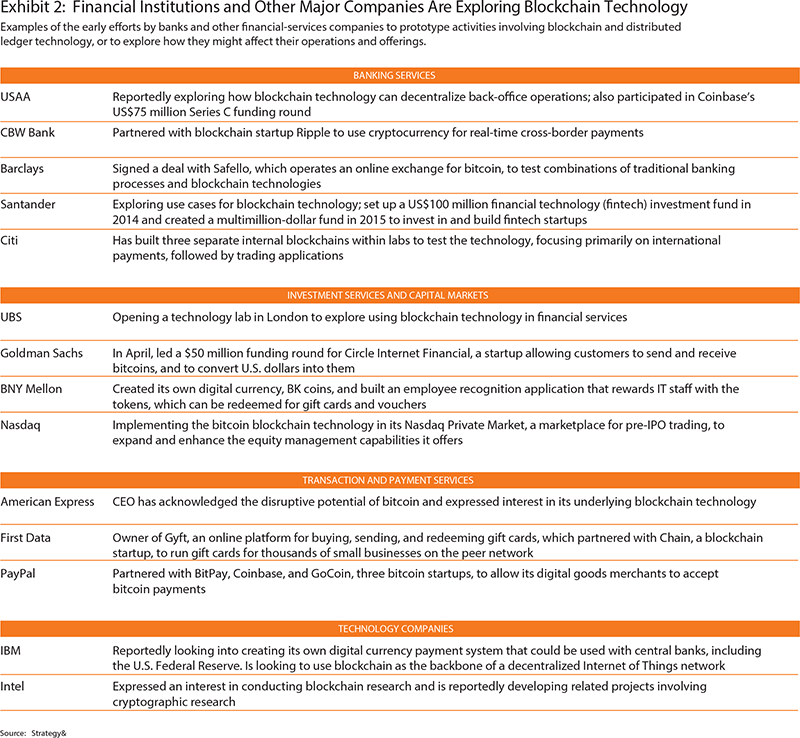Yesterday we highlighted the IMF report on virtual currencies. Underlying this are blockchain technologies. Strategy&’s s+b have published a long article “A Strategist’s Guide to Blockchain” which is worth reading in full. Here is a brief extract:
The name of the technology that could make all this happen is blockchain. Originally the formal name of the tracking database underlying the digital currency bitcoin, the term is now used broadly to refer to any distributed electronic ledger that uses software algorithms to record transactions with reliability and anonymity. This technology is also sometimes referred to as distributed ledgers (its more generic name), cryptocurrencies (the electronic currencies that first engendered it), bitcoin (the most prominent of those cryptocurrencies), and decentralized verification (the key differentiating attribute of this type of system).
At its heart, blockchain is a self-sustaining, peer-to-peer database technology for managing and recording transactions with no central bank or clearinghouse involvement. Because blockchain verification is handled through algorithms and consensus among multiple computers, the system is presumed immune to tampering, fraud, or political control. It is designed to protect against domination of the network by any single computer or group of computers. Participants are relatively anonymous, identified only by pseudonyms, and every transaction can be relied upon. Moreover, because every core transaction is processed just once, in one shared electronic ledger, blockchain reduces the redundancy and delays that exist in today’s banking system.
Companies expressing interest in blockchain include HP, Microsoft, IBM, and Intel. In the financial-services sector, some large firms are forging partnerships with technology-focused startups to explore possibilities. For example, R3, a financial technology firm, announced in October 2015 that 25 banks had joined its consortium, which is attempting to develop a common crypto-technology-based platform. Participants include such influential banks as Citi, Bank of America, HSBC, Deutsche Bank, Morgan Stanley, UniCredit, Société Générale, Mitsubishi UFG Financial Group, National Australia Bank, and the Royal Bank of Canada. Another early experimenter is Nasdaq, whose CEO, Robert Greifeld, introduced Nasdaq Linq, a blockchain-based digital ledger for transferring shares of privately held companies, also in October 2015.
If experiments like these pan out, blockchain technology could become a game-changing force in any venue where trading occurs, where trust is at a premium, and where people need protection from identity theft — including the public sector (managing public records and elections), healthcare (keeping records anonymous but easily available), retail (handling large-ticket purchases such as auto leasing and real estate), and, of course, all forms of financial services. Indeed, some farsighted banks are already exploring how blockchain might transform their approaches to trading and settling, back-office operations, and investment and capital assets management. They recognize that the technology could become a differentiating factor in their own capabilities, enabling them to process transactions with more efficiency, security, privacy, reliability, and speed. It is possible that blockchain could transform transactions to the same degree that the global positioning system (GPS) transformed transportation, by making data accessible through a common electronic platform.
Blockchain could become a force anywhere trading occurs, trust is at a premium, and people need protection from identity theft.
But although the potential is immense, so is the uncertainty. Distributed ledger technologies are so new, so complex, and so prone to rapid change that it’s difficult to predict what form they will ultimately take — or even to be sure they will work. The Gartner Group declared in an August 2015 report that crypto-currency was traveling a “hype cycle”: it had passed the Peak of Inflated Expectations and was headed for the Trough of Disillusionment. Another research firm, Forrester, titled its 2015 blockchain report “Don’t Believe in Miracles,” advising enterprises to wait five to 10 years before introducing blockchain, in part because of legal restrictions.
On the other hand, some authorities advocate energetic R&D. “The distributed payment technology embodied in bitcoin has real potential,” said Andrew Haldane, chief economist of the Bank of England, in September 2015. “On the face of it, it solves a deep problem in monetary economics: how to establish trust — the essence of money — in a distributed network.”
If you are a senior executive in a financial-services firm, you may already be experimenting with distributed ledger technologies, if only to see how they fit with your strategy. You have lots of company. By 2014, more than a dozen major companies were actively exploring blockchain-related ventures and their potential effect on core practices (see Exhibit 2). For example, blockchain might streamline transaction processing by establishing a single source of truth, available to all, updated in near-real time. This could increase the speed of exchange, reduce the number of intermediaries (and the costs associated with them), improve security, digitize assets, give wider access to people who don’t have bank accounts, enable better bookkeeping, and improve regulatory compliance.

